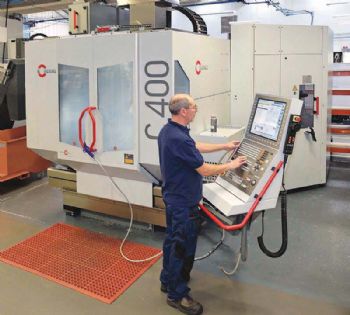
The catastrophic failure of a five-axis machining centre, coupled with a requirement to continue supplying 12 aircraft-seat tray-table assemblies per day that were being produced on it, would be a nightmare scenario for any sub-contractor, but this was the problem faced by Weymouth-based FGP Systems last year.
The solution was to buy a new German-built Hermle C 400 machining centre, which was supplied in September by sole UK agent Geo Kingsbury, Gosport (
www.geokingsbury.com), with a lead time of two weeks.
After commissioning and training, the five-axis vertical-spindle machine was producing parts just three weeks from the order being placed, and Geo Kingsbury moved it to a new and permanent location three months later (four days before the Christmas break).
Simon Griffiths-Hughes, FGP’s director of engineering, said: “No other potential provider of a quality five-axis machining centre was able to react so quickly, with 14-16 weeks being the normal lead time for a machine built to order.
Fortunately, Geo Kingsbury had the Hermle C 400 in stock at its Gosport showroom, and the machine was perfectly specified for our requirements, with spindle-nose probing, laser tool setting, HSK 63 tools, an extended 87-station magazine and an 18,000rev/min spindle for the efficient machining of aluminium.
“Before we placed the order, we spoke with several UK users of Hermle equipment — from blue-chip firms to small sub-contractors — and all endorsed the brand.”
Change of supplier
Nigel Pitman, FGP’s managing director, added: “To change from the incumbent supplier of our nine five-axis machining centres to Hermle was a huge decision for us.
“We had been talking to Geo Kingsbury for about 18 months regarding purchasing a C 42 U five-axis machine for another project, which unfortunately did not go ahead. We had already done a lot of research, which included a visit to the German factory, and a number of features of the Hermle machines impressed us.
“For example, the trunnion bearings are much bigger than on most five-axis machines; and even something straightforward like the swarf conveyor made us take notice.
Some manufacturers provide a ‘swan neck’ exit that I reckon is too high and narrow for the efficient removal of chips, whereas Hermle’s conveyor is low-rise — and as wide as the machining area.”

Mr Pitman says the machine has not missed a beat since it was installed, despite running double shifts, seven days a week. It has been more or less devoted to producing a family of components from aluminium billets for the aircraft-seat tray tables.
The first operation on the main part involves three-axis milling with two axes clamped, while the second operation requires a fully interpolative five-axis cycle.
Furthermore, the high quality of surface finish achieved by the Hermle is saving FGP a considerable amount of time.
The finish that FGP was previously achieving was causing difficulties, as the grey anodising stipulated by the customer tended to show up every machining mark left by ball-nose milling cutters.
Many hours of manual polishing were needed to remove the marks; now, components go straight from the Hermle to anodising without any further work.
‘Frill-free’ option
The C 400 is a model from a new lower-priced machine series that sits alongside Hermle’s established range. It has the same gantry design and mineral cast bed, so it offers rigidity, low vibration, high accuracy and overall quality.
The main difference is that fewer options are available — a limitation that does not affect FGP’s range of applications.
Control is via Heidenhain’s TNC 640, which Mr Griffiths-Hughes says is popular with machine operators due to its ease of use, large colour monitor and built-in Hermle macros, which provide support for complex milling.
Moreover, programs can be transferred seamlessly from FGP’s other five-axis machines, which all feature earlier TNC control systems; and while there is no turning capability on the rotary table of the C 400, the TNC 640 has the option of software for ‘interpolation turning’.
This uses circular movement of the X and Y axes, synchronised rotation of a turning tool in the spindle and simultaneous feed in Z to single-point profile-turn circular features on the inside or outside of a static component on the table.
Mr Pitman says that with a lot of big flanges requiring recesses going through the machine shop at Weymouth, the extra software is likely to be an early addition when the tray-table contract is moved to an automated production cell at the factory and the C 400 is used for other work.
In conclusion, he said: “You need reliable machines in sub-contracting, especially when serving the aerospace market — not thoroughbreds that are highly productive one minute and then break down the next. It is early days yet, but it seems that the Hermle is going to give us the uptime we need — and the quality.”